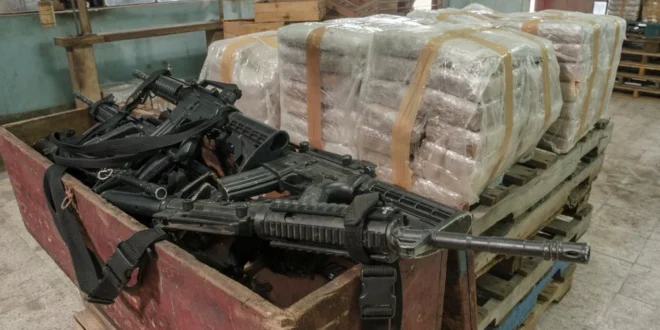Cutting all maritime smuggling routes is the best way to defeat the cartels, their Chinese enablers, and the Fentanyl overdose epidemic.
In the fight to secure our nation from dangerous illicit drugs, the Joint Interagency Task Force South (JIATF-S), based in Key West, Florida, has been waging a successful regional coalition for decades. Despite this effort, victory has been elusive, given few resources and a constrained U.S. focus, allowing the cartels to adapt and survive.
There is urgency to act. The United States is suffering from a pandemic of illicit narcotics, notably fentanyl, which killed over 73,000 Americans last year. Putting an end to this deadly trade will require strangling the narco-cartels by cutting their illicit smuggling networks connecting Latin America, China, and the United States.
Defeating the cartels behind the drug trade requires more than just cutting off the trade in fentanyl to the United States. After all, the cartels deal in more than one drug and more than one market. Their trafficking services North American and European customers who have not lost their appetite for cocaine, a drug now experiencing a post-COVID surge in production.
Hitting the cartels’ bottom line will require intercepting both shipments of cocaine and the precursor chemicals needed for fentanyl production. Critically, the cartels rely on several sea routes to move 90 percent of their drugs. The most important sea routes cross the Pacific with precursor chemicals from China and cocaine from South America to intermediary stops before moving into the United States or via Europe’s most porous border in French Guiana. Smugglers are attracted to French Guiana since, once inside, they can use local drug mules to access direct flights to Europe with fewer customs and immigration restraints.
Established in 1989, the Joint Interagency Task Force South has had measured success interdicting this illicit trade. However, it has not been able to deliver a knockout blow to the cartels. Today, officials assert they are, on average, only interdicting approximately 10 percent of this illicit trade, given too few Coast Guard cutters and patrol aircraft at their disposal.
By integrating multiple U.S. agencies, JIATF-S has leveraged twenty-one regional partners’ maritime policing capacities with timely intelligence sharing. This has made a meaningful but not a mortal impact on the cartels. The collaboration has resulted in almost 80 percent of JIATF-S’ drug seizures being executed by regional partner nations. But sadly, this impacts only a fraction of the cartels’ overall bottom line.
Last year, JIATF-S enabled the capture of over $7 billion worth of narcotics. This is good but not good enough, given the global trade in narcotics was estimated at over $652 billion in 2017. In 2020, it’s estimated that almost 2,000 tons of undiluted cocaine were produced. If well placed, a single Coast Guard cutter on station can take fifty tons of narcotics out of supply. Still, this is not good enough, making greater partner nations’ active support critical moving forward.
Securing Americans from the scourge of illegal drugs will mean actually putting the cartels out of business. Doing this will require cutting the cartels’ critical narcotics maritime trade routes—not only south-to-north routes to North America but also the other routes that keep them in business.
In the past, cartel transit routes have adapted as interdiction grew more effective in the Caribbean, with cocaine smugglers shifting to transit routes via West Africa to Europe. Importantly, in recent years, the cartels have expanded their European operations, making it a significant part of their bottom line.
Unfortunately, the establishing legislation for JIATF-S focuses only on routes from Latin America to the United States. This has prevented broader interdiction on a scale that would seriously threaten the cartels’ bottom line. Fixing this will require reframing the current mandate of JIATF-S to focus on cutting all the sea routes on which the cartels rely.
An unholy alliance between the cartels and Chinese chemical suppliers is delivering massive profits to crime syndicates on both sides of the Pacific. As in Europe and Africa, increased criminality is weakening Latin American governments that are being exploited by the cartels and the Chinese criminal gangs—notably the Bang Group. This is already apparent as Venezuela slides deeper into criminality and active support of the drug trade while China courts a weakened Maduro government.
The bottom line is that China benefits by operating on both sides of the narcotics trade: Chinese criminal gangs generate income and influence while weakening local governments. Those weakened governments then turn to China for policing assistance to fight the very crime their crime gangs are spreading—see, for example, the experience of the Republic of Palau.
Exposure of China’s hand in these nefarious networks is needed but too seldom seen. On a rare occasion this October, the Justice Department announced indictments against eight Chinese companies and twelve Chinese nationalsinvolved in illegally shipping fentanyl precursor chemicals to the United States. That said, the scope of illicit Chinese activity in the Western Hemisphere is likely higher than publicly reported, and the sooner China held to account to begin meaningfully curtailing this trade, the better.
The critical issue is that focusing on only cocaine and fentanyl headed to the United States will not be enough to destroy the cartels behind the illicit narcotics trade. To up the pain on the cartels, JIATF-S needs more cutters and aircraft to halt this illegal trade.
Doing this better and more comprehensively targets the cartels’ business model. Cutting off their access to sea routes will squeeze their bottom line where they are most exposed. A comprehensive approach building on the success of JIATF-S with additional platforms and authorities can finally and mortally smash the cartels.
Brent Sadler is a Senior Research Fellow in the Center for National Defense at The Heritage Foundation.
James Di Pane is a policy analyst at the Center.
 Geostrategic Media Political Commentary, Analysis, Security, Defense
Geostrategic Media Political Commentary, Analysis, Security, Defense





